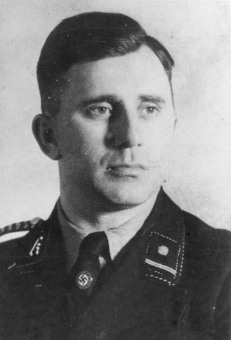Bernhard Rakers (1905–1980)

© Fritz Bauer Institute
Bernhard Rakers, who was born in Sögel in the Emsland district in 1905, came from a modest background. His father was a barkeeper and rail forwarding agent; his mother was a housewife. After attending the public elementary and junior high schools in his native town, Rakers was apprenticed as a baker and subsequenrly passed his journeyman’s examination. He passed the exam for his master’s certificate in 1930. An occupational illness caused Rakers to give up this work in late 1933, and he found himself out of a job. As early as March 1933, he had joined the NSDAP and the SA, and in February 1934 he applied for a job as a guard in the early concentration camps in the Emsland district. The Emsland camps (Börgermoor, Esterwegen, and others) had been set up by the SA. An accident forced Rakers to interrupt his training as a concentration camp guard, and after retraining as a cook, he was assigned to the Esterwegen concentration camp. He worked first in the SS kitchen, and later in the camp kitchen. In fall 1934, in the course of the takeover of the Emsland camps by the SS, he became a member of the SS-Totenkopfverbände, the Death’s Head units of the SS. Rakers was promoted to the rank of SS-Scharführer in May 1937 and to SS-Oberscharführer in 1939; in May 1940 he became an SS-Hauptscharführer (equivalent Wehrmacht rank: Oberfeldwebel). He held this SS rank until the end of the war.
The Esterwegen concentration camp was closed in summer 1936, and Rakers was transferred to the Sachsenhausen concentration camp. There he worked as a cook until fall 1942. For “peculations and misappropriation of provisions,”[1] that is, for taking groceries entrusted to his management, the SS Economic and Administrative Main Office (Wirtschafts- und Verwaltungshauptamt, WVHA) transferred him to the Auschwitz concentration camp. For a short time, Rakers headed the pipe-laying detachment (Ruta AG) in Auschwitz I (main camp) and then, in early 1943, he went to I.G. Farben’s corporate concentration camp, Buna/Monowitz. Here he became a detachment leader, in command of the entire Buna detachment. In the morning, together with the SS guard detachment under his control, he accompanied the slave laborers of I.G. Farbenindustrie AG to the plant grounds, and in the evening he escorted them back to the camp. At the I.G. Auschwitz construction site, he, the SS guards, the Kapos, and the master craftsmen of I.G. Farben and its subcontractors supervised the work detachments.
Complaints lodged against Rakers due to his cruelty and brutality toward prisoners led to his replacement. The transfer, however, did not work to Rakers’s detriment; on the contrary, he rose to become roll-call leader in the Buna/Monowitz concentration camp. In this function, his duties included conducting the roll calls and determining the number of people present in the camp. For various wrongs, Rakers was transferred once again, this time in December 1944, from the Buna/Monowitz concentration camp to the subcamp Gleiwitz II (Deutsche Gas-Ruß-Werke GmbH, headquartered in Dortmund). In the Upper Silesian branch camp, he had the role of camp head. When the Auschwitz main camp and subcamps were closed in mid-January 1945, Rakers, along with SS-Hauptscharführer Otto Moll (1915–1946), was in charge of a prisoner transport from Gleiwitz via Pregarten (near Mauthausen, in Austria) to Sachsenhausen (near Berlin). In February 1945, he went from Sachsenhausen to the Weimar-Gustloff-Werke subcamp of the Buchenwald concentration camp, again as head of the camp. When the war ended, Rakers was taken prisoner by the Americans and later sent to a French POW camp. From April to July 1948, he was in the Fallingbostel internment camp.
In the de-Nazification proceedings involving Rakers, the Bielefeld Spruchgericht (special de-Nazification court) sentenced Rakers in December 1948 to 2 ½ years in prison because of his membership in the SS. The court gave him credit for the time served in the POW and internment camps, and released him. Rakers, returning to the vocation he had learned as a youth, worked as a baker in Lingen until his arrest on July 24, 1950.
Rakers served the sentence of lifelong imprisonment imposed in his first trial primarily in the Celle Penal and Detention Facility. He was given his freedom in mid-1971, after Prime Minister of Lower Saxony Alfred Kubel (SPD; Social Democratic Party of Germany) granted a plea for clemency. Rakers once again found employment as a baker, and he died in 1980.
(WR; transl. KL)
















